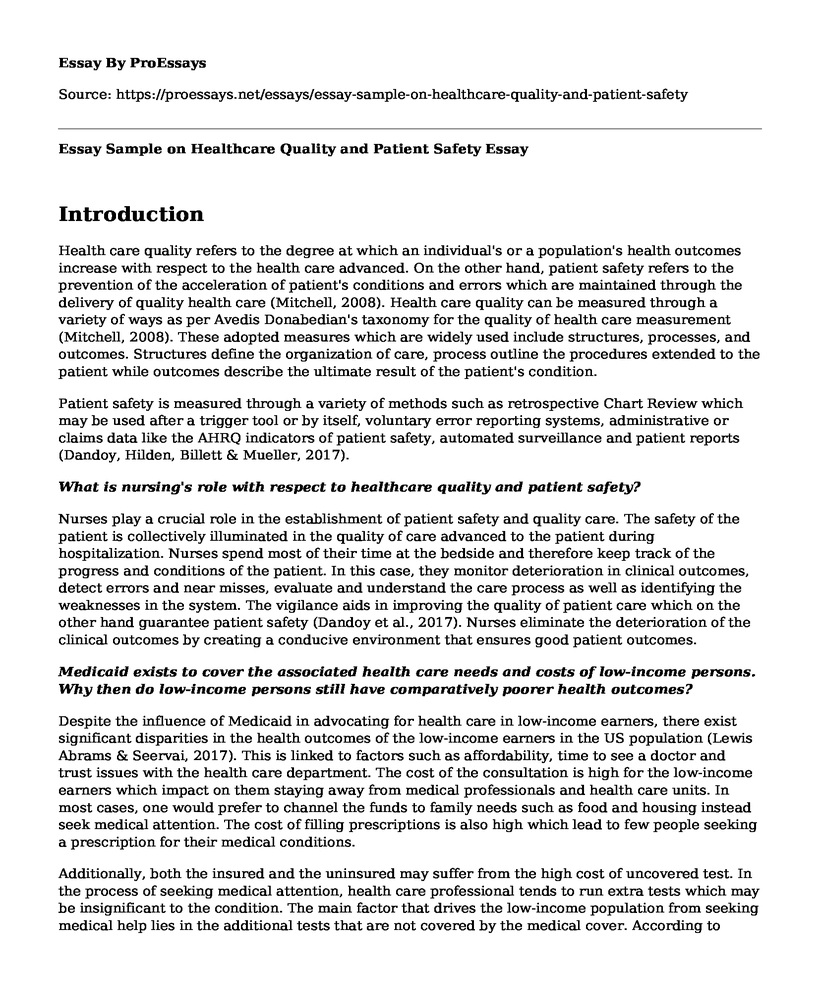Introduction
Health care quality refers to the degree at which an individual's or a population's health outcomes increase with respect to the health care advanced. On the other hand, patient safety refers to the prevention of the acceleration of patient's conditions and errors which are maintained through the delivery of quality health care (Mitchell, 2008). Health care quality can be measured through a variety of ways as per Avedis Donabedian's taxonomy for the quality of health care measurement (Mitchell, 2008). These adopted measures which are widely used include structures, processes, and outcomes. Structures define the organization of care, process outline the procedures extended to the patient while outcomes describe the ultimate result of the patient's condition.
Patient safety is measured through a variety of methods such as retrospective Chart Review which may be used after a trigger tool or by itself, voluntary error reporting systems, administrative or claims data like the AHRQ indicators of patient safety, automated surveillance and patient reports (Dandoy, Hilden, Billett & Mueller, 2017).
What is nursing's role with respect to healthcare quality and patient safety?
Nurses play a crucial role in the establishment of patient safety and quality care. The safety of the patient is collectively illuminated in the quality of care advanced to the patient during hospitalization. Nurses spend most of their time at the bedside and therefore keep track of the progress and conditions of the patient. In this case, they monitor deterioration in clinical outcomes, detect errors and near misses, evaluate and understand the care process as well as identifying the weaknesses in the system. The vigilance aids in improving the quality of patient care which on the other hand guarantee patient safety (Dandoy et al., 2017). Nurses eliminate the deterioration of the clinical outcomes by creating a conducive environment that ensures good patient outcomes.
Medicaid exists to cover the associated health care needs and costs of low-income persons. Why then do low-income persons still have comparatively poorer health outcomes?
Despite the influence of Medicaid in advocating for health care in low-income earners, there exist significant disparities in the health outcomes of the low-income earners in the US population (Lewis Abrams & Seervai, 2017). This is linked to factors such as affordability, time to see a doctor and trust issues with the health care department. The cost of the consultation is high for the low-income earners which impact on them staying away from medical professionals and health care units. In most cases, one would prefer to channel the funds to family needs such as food and housing instead seek medical attention. The cost of filling prescriptions is also high which lead to few people seeking a prescription for their medical conditions.
Additionally, both the insured and the uninsured may suffer from the high cost of uncovered test. In the process of seeking medical attention, health care professional tends to run extra tests which may be insignificant to the condition. The main factor that drives the low-income population from seeking medical help lies in the additional tests that are not covered by the medical cover. According to Lewis et al. (2017), most low-income earners experience difficulties in taking sick leave as they are not paid on sick leave. In that light, they tend to stay on duty with the pain with the aim of increasing their income.
On the other hand, booking an appointment with a doctor during off duty hours is difficult as getting the doctors proves hectic. Another factor that contributes to low health outcomes in the low-income population despite the availability of Medicaid for the population is the loss of trust in the health care system. Most low-income earners have a poor experience with medical providers and tend to shy from healthcare units. Some cite the healthcare units to be driven with the motive of making more profits which lead to the prescription of a lot of drugs.
References
Dandoy, C. E., Hilden, J. M., Billett, A. L., & Mueller, B. U. (2017). Quality Improvement and Patient Safety Resources. In Patient Safety and Quality in Pediatric Hematology/Oncology and Stem Cell Transplantation (pp. 361-368). Springer, Cham.
Lewis, C., Abrams, M., & Seervai, S. (2017). Obstacles for low-income patients. Retrieved from https://www.commonwealthfund.org/blog/2017/listening-low-income-patients-obstacles-care-we-need-when-we-need-itMitchell, P. H. (2008). Defining patient safety and quality care.
Cite this page
Essay Sample on Healthcare Quality and Patient Safety. (2022, Nov 30). Retrieved from https://proessays.net/essays/essay-sample-on-healthcare-quality-and-patient-safety
If you are the original author of this essay and no longer wish to have it published on the ProEssays website, please click below to request its removal:
- Epidemic of Mental Health Issues in Youths of Affluent Families Paper Example
- PICOT Question and Its Significance in Nursing Practice Paper Example
- Paper Example on Use of Evidence-Based Communication, Change Processes, and Intervention
- The Head Start Policy Program Evaluation Paper Example
- Academic Dishonesty: Impact on Nursing Enrollment - Essay Sample
- Nurses: Key to Quality Healthcare and Reducing Healthcare Costs - Essay Sample
- Essay Example on My Learning Journey: Taking Responsibility & Improving Myself







